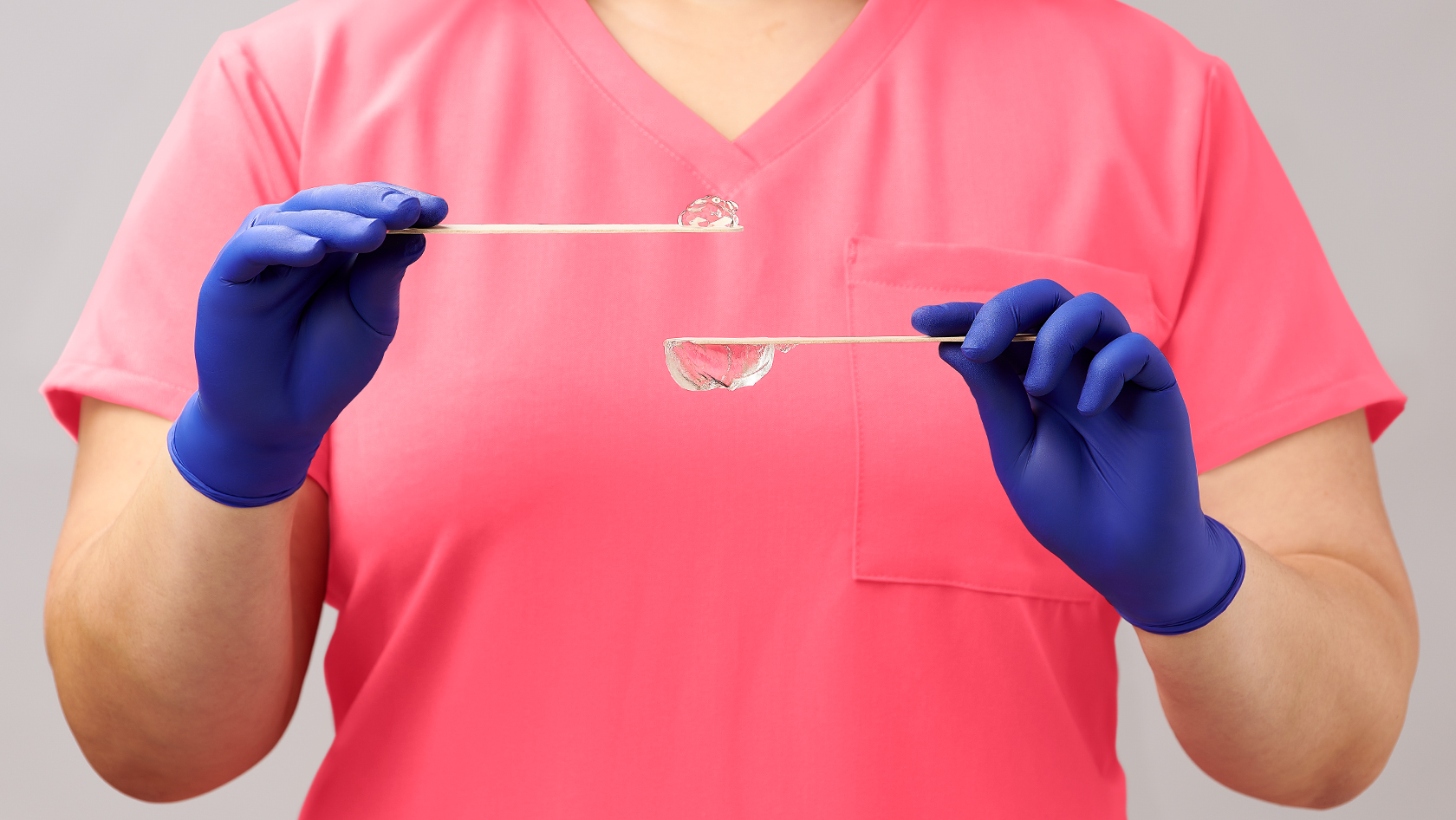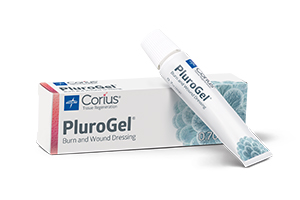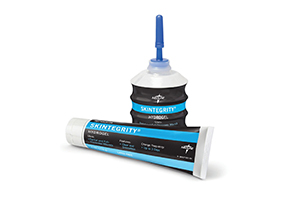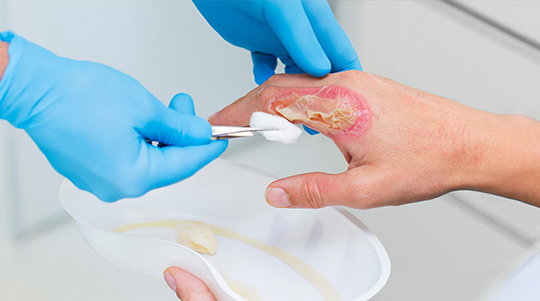PluroGel® vs. hydrogel: What’s the difference?
Clinicians want to know how these two gels stack up.

For hard-to-heal wounds, clinicians are always looking for the right treatment options to provide gentle debridement. And they want to know: Is PluroGel the same as hydrogel?
The short answer is no—from the ingredients they use to their ability to target biofilm, there are significant differences between these two products.
Some manufacturers of hydrogels claim that PluroGel is a “more expensive hydrogel,” but that’s a myth. Read on to learn more about which product is most effective at removing barriers to healing.
How do these gels compare?
PluroGel Burn and Wound Dressing is the first and only concentrated surfactant. It features a unique mechanism of action to keep pathogens away from the wound bed. That’s key for preventing biofilm—a major barrier to healing—from forming. The high concentration of surfactant micelles in this gel dressing also provides gentle debridement, exudate control and hydration for wounds. Clinicians who want to experience this breakthrough technology in action can request a PluroGel sample.
Hydrogels are a category of products that keep wounds moist and promote healing through debridement and tissue regeneration. They come in the form of gels, sheets and impregnated dressings.
PluroGel vs. Hydrogel
PluroGel

Recommended wound types
Non-healing wounds with suspected biofilm presence, partial- and full-thickness wounds, second-degree burns, pressure injuries, surgical wounds, trauma wounds and chronic wounds, such as VLUs and DFUs, tunneling/undermining wounds, dry- to moderate-exudate wounds
Not appropriate for
High-exudate wounds, patients with known hypersensitivity to product
Composition
Water, poloxamer, phenosyethanol, sodium phosphate, potassium sorbate, citric acid
Hydrogel

Recommended wound types
Partial- and full-thickness wounds, second-degree burns, pressure injuries, surgical wounds, trauma wounds and chronic wounds, tunneling/undermining wounds, dry to low exudate wounds
Not appropriate for
Hydrating dessicated wounds, dry macerated wounds, full-thickness burns, moderate- to high-exudate wounds
Composition
Water, acrylic polymers, poly-ethylene, phenoxyethanol
Why clinicians prefer PluroGel
Removes barriers to healing like biofilm, debris and slough
Unlike hydrogels, PluroGel prevents biofilm from forming, as well as disrupts mature biofilm.1 Micelle Matrix technology™ ensures that the gel remains in intimate contact with the wound bed, preventing biofilm and other pathogens from attaching. Surfactant micelles also work to soften, loosen and drive away to trap slough and necrotic debris. The proven surfactant remains a thick gel for up to three days while most hydrogels can liquify, allowing pathogens to reach the wound. PluroGel has no contraindications and works well with other biofilm-management products.
PluroGel also helps reduce wound size and remove non-vital debris and slough, leading to improvements in the appearance of the wound bed.2 In the video case study below, Dr. Lee C. Ruotsi, MD, ABWMS, CWS-P, UHM and Medical Director of the Advance Wound Healing Program in Buffalo, New York, details how PluroGel advanced healing for a 52-year-old man with a three-year history of VLUs and why his team values this concentrated surfactant.
Speeds up burn wound declaration
Every wound is different. PluroGel helps burn wounds declare faster. This gives clinicians the information they need to know if a wound will go on to heal or require surgery.
“It does more rapidly make or declare the wound as a healing wound versus a wound that needs an operation,” as John A. Griswold, MD, FACS and Medical Director of the Timothy J Harnar Burn Unit puts it. “All the other dressing application products that we use, we have to clean that or debride it or wipe it away every day. [PluroGel] just makes the wound care less difficult, and that’s why the patients are more comfortable.”
Watch the video below to learn more about why Dr. Griswold’s team values PluroGel:
No risk of maceration
Hydrogels must be applied carefully to prevent the gel from macerating the wound. But there’s no risk of wound maceration with PluroGel. That means it’s easier to apply for everyone, from clinicians to patients to family members. While regular dressing changes are important, there’s peace of mind in knowing that the wound won’t macerate if a changing must be missed.
Easy, less painful dressing changes
PluroGel helps create a better patient experience. Here’s how it works: The gel is applied to the dressing, which is then applied to the wound. When it’s time to change the dressing, the water-soluble gel is easily and gently removed with water or cleanser. That means there’s no harsh wiping or disruption to new healthy tissue. The result: patients report less pain and anxiety during changes.
PluroGel’s no-sting formula soothes and cools, helping to reduce pain during dressing changes.3 Naiwei Hsu-Chang, CCRN, Medline consultant and lead RN at Burn Center of Torrance Memorial Medical Center in California has worked in burn care for 35 years. She knows that pain during dressing changes can slow down treatment, which is part of the reason she uses PluroGel. She explains, “[PluroGel] helps people feel less discomfort, it cuts down on dressing change time and saves valuable nursing time.” She adds that it is gentle on the wound bed.
“[PluroGel] helps people feel less discomfort, it cuts down on dressing change time and saves valuable nursing time.”

Naiwei Hsu-Chang
lead RN at the Burn Center of the Torrance Memorial Medical Center in California, CCRN and Medline consultant
Key takeaway
It’s easy to see why surgeons, physicians and nurses rely on the innovative properties of PluroGel. It offers many advantages over hydrogels. The key difference is that PluroGel is proven to fight biofilm. It also aids with burn wound declaration, patient comfort during dressing changes and the prevention of wound maceration.
References:
- Yang, Q., Larose, C., Della Porta, A. C., Schultz, G. S., & Gibson, D. J. (2017). A surfactant-based wound dressing can reduce bacterial biofilms in a porcine skin explant model. International wound journal, 14(2), 408–413. https://doi.org/10.1111/iwj.12619
- Ratliff CR. Management of a Groin Wound Using a Concentrated Surfactant-Based Gel Dressing. Journal of Wound, Ostomy, and Continence Nursing. 2018 Sep/Oct;45(5):465-467. DOI: 10.1097/won.0000000000000467. https://journals.lww.com/jwocnonline/Abstract/2018/09000/Management_of_a_Groin_Wound_Using_a_Concentrated.12.aspx
- Data on file.




